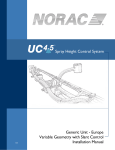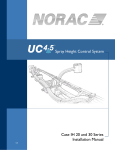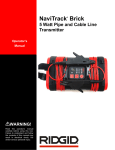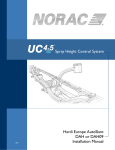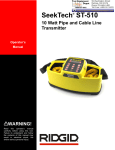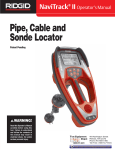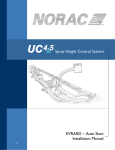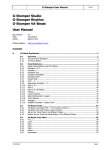Download RIDGID NaviTrack 10 Operator`s manual
Transcript
® NaviTrack 10 Watt Pipe and Cable Line Transmitter Operator’s Manual CAUTION! WARNING! For your own safety, read this Read this Operator’s Manualoperator’s carefully andmanual carefully before using this completely before assembling and tool. Failure this to understand follow operating unit. Learn theand operation, the contents of this manual applications and potential hazards tomay result this unit.in electrical shock, fire and/or serious personal injury. Table of Contents GENERAL SAFETY INFORMATION........................................................................................................................ 2 TRANSMITTER COMPONENTS .............................................................................................................................. 5 GETTING STARTED ................................................................................................................................................. 6 INSTALLING/CHANGING BATTERIES ............................................................................................................................ 6 OPERATION TIME ..................................................................................................................................................... 6 OPTIONAL EXTERNAL POWER SOURCE...................................................................................................................... 6 KEYPAD .................................................................................................................................................................... 7 POWERING UP AND DOWN ........................................................................................................................................ 7 SOUNDS OF THE NAVITRACK TRANSMITTER ............................................................................................................... 7 USING THE NAVITRACK LINE TRANSMITTER ..................................................................................................... 7 DIRECT CONNECT METHOD .................................................................................................................................. 8 USEFUL OPERATING POINTS ................................................................................................................................... 10 INDUCTIVE CLAMP METHOD ............................................................................................................................... 10 INDUCTIVE MODE.................................................................................................................................................. 11 FEATURES.............................................................................................................................................................. 12 VARIABLE POWER OUTPUT ..................................................................................................................................... 12 BATTERY LEVEL INDICATOR .................................................................................................................................... 13 AUTO-SHUTDOWN .................................................................................................................................................. 13 25’ COIL CORDS (EXTENDED) ................................................................................................................................. 13 HIGH VOLTAGE INDICATOR...................................................................................................................................... 13 USEFUL INFORMATION ........................................................................................................................................ 14 RESISTANCE AND IMPEDANCE ................................................................................................................................. 14 USING HIGH AND LOW FREQUENCIES ...................................................................................................................... 14 FCC LIMITS ........................................................................................................................................................... 15 TRANSPORTATION AND STORAGE ............................................................................................................................ 15 MAINTENANCE AND CLEANING ................................................................................................................................ 15 LOCATING FAULTY COMPONENTS............................................................................................................................ 15 SERVICE AND REPAIR ............................................................................................................................................. 15 ICON LEGEND ......................................................................................................................................................... 16 ESTIMATED OPERATING TIMES ................................................................................................................................ 16 STANDARD EQUIPMENT .......................................................................................................................................... 16 FCC LIMITS ........................................................................................................................................................... 16 TROUBLE SHOOTING GUIDE ............................................................................................................................... 17 SPECIFICATIONS................................................................................................................................................... 17 ii www.navitrack.com Ridge Tool Company Elyria, Ohio U.S.A NaviTrack® Line Transmitter NaviTrack ® 10 Watt Line Transmitter NaviTrack ® 10W Line Transmitter Record the Serial Number of your unit below and retain for your records. See bottom panel for serial number. Serial Number Ridge Tool Company Elyria, Ohio U.S.A www.navitrack.com 1 General Safety Information Battery Precautions • WARNING Read and understand all instructions. Failure to follow all instructions listed below may result in electric shock, fire, and/or serious injury. • • SAVE THESE INSTRUCTIONS! Work Area Safety • • • Keep your work area clean and well lit. Cluttered benches and dark areas may cause accidents. Do not operate electrical devices or power tools in explosive atmospheres, such as in the presence of flammable liquids, gases, or heavy dust. Electrical devices or power tools create sparks which may ignite the dust or fumes. Keep bystanders, children, and visitors away while operating tool. Distractions can cause you to lose control. • • • • 2 Do not attach the leads to a high voltage line. Do not operate the system with electrical components removed. Exposure to internal parts increases the risk of injury. Avoid exposure to rain or wet conditions. Keep battery out of direct contact with water. Water entering electrical devices increases the risk of electric shock. Use only in the manner specified. Protection provided by the equipment may be impaired if used in a manner not specified by the manufacturer. Do not open the transmitter case. High voltages are present and no serviceable parts are available. www.navitrack.com Recharge batteries with charging units specified by the battery manufacturer. Using an improper charger can overheat and rupture the battery. Properly dispose of the batteries. Exposure to high temperatures can cause the battery to explode, so do not dispose of in a fire. Some countries have regulations concerning battery disposal. Please follow all applicable regulations. Personal Safety • • • Electrical Safety • Use only the size and type of battery specified. Do not mix cell types (e.g. do not use alkaline with rechargeable). Do not use partly discharged and fully charged cells together (e.g. do not mix old and new). • • • • Avoid Traffic. Pay close attention to moving vehicles when using on or near roadways. Wear visible clothing or reflector vests. Such precautions may prevent serious injury. Stay alert, watch what you are doing and use common sense. Do not use tool while tired or under the influence of drugs, alcohol, or medications. A moment of inattention while operating tools may result in serious personal injury. Gloves should always be worn for health and safety reasons. Sewer lines are unsanitary and may contain harmful bacteria and viruses. Do not overreach. Keep proper footing and balance at all times. Proper footing and balance enables better control of the tool in unexpected situations. Use safety equipment. Always wear eye protection. Dust mask, non-skid safety shoes, hard hat, or hearing protection must be used for appropriate conditions. Use proper accessories. Do not place this product on any unstable cart or surface. The product may fall causing serious injury to a child or adult or serious damage to the product. Prevent object and liquid entry. Never spill liquid of any kind on the product. Liquid increases the risk of electrical shock and damage to the product. Ridge Tool Company Elyria, Ohio U.S.A NaviTrack® Line Transmitter NaviTrack Line Transmitter Use and Care • • • • • • • • Use equipment only as directed. Do not operate the NaviTrack Transmitter unless proper training has been completed and the owners manual read Do not immerse the leads or case in water. Store in a dry place. Such measures reduce the risk of electric shock and equipment damage. Store idle tools out of the reach of children and other untrained persons. Tools are dangerous in the hands of untrained users. Maintain tools with care. Properly maintained tools are less likely to cause injury. Check for breakage of parts, and any other conditions that may affect the NaviTrack’s operation. If damaged, have the tool serviced before using. Many accidents are caused by poorly maintained tools. Use only accessories that are recommended by the manufacturer for your tool. Accessories that may be suitable for one tool may become hazardous when used on another tool. Keep handles dry and clean; free from oil and grease. Allows for better control of the tool. Protect against excessive heat. The product should be situated away from heat sources such as radiators, heat registers, stoves or other products (including amplifiers) that produce heat. Service • • • • Tool service must be performed only by qualified repair personnel. Service or maintenance performed by unqualified repair personnel could result in injury. When servicing a tool, use only identical replacement parts. Follow instructions in the Maintenance Section of this manual. Use of unauthorized parts or failure to follow maintenance instructions may create a risk of electrical shock or injury. Follow instructions for changing accessories. Accidents are caused by poorly maintained tools. Provide proper cleaning. Remove battery before cleaning. Do not use liquid cleaners or aerosol cleaners. Use a damp cloth for cleaning. Ridge Tool Company Elyria, Ohio U.S.A • • Conduct a safety check. Upon completion of any service or repair of this product, ask the service technician to perform safety checks to determine that the product is in proper operating condition. Damage to the product that requires service. Remove the batteries and refer servicing to qualified service personnel under any of the following conditions: o If liquid has been spilled or objects have fallen into product; o If product does not operate normally by following the operating instructions; o If the product has been dropped or damaged in any way; o When the product exhibits a distinct change in performance. CAUTION Remove batteries entirely before shipping. If you have any questions regarding the service or repair of this machine, call or write to: Ridge Tool Company Technical Service Department 400 Clark Street Elyria, Ohio 44035-6001 Tel: (800) 519-3456 E-mail: [email protected] www.ridgid.com In any correspondence, please give all the information shown on the nameplate of your tool including model number and serial number. WARNING NaviTrack and SeekTech locators are diagnostic tools that sense electromagnetic fields emitted by objects underground. They are meant to aid the user in locating these objects by recognizing characteristics of their field lines and displaying them on the screen. As electromagnetic field lines can be distorted and interfered with it is important to verify the location of underground objects before digging. Exposing the utility is the only way to verify its existence, location and depth. Ridge Tool Co., its affiliates and suppliers, will not be liable for any injury or any direct, indirect, incidental or consequential damages sustained or incurred by reason of the use of the NaviTrack. www.navitrack.com 3 DANGER ALWAYS HOOK UP LEADS FIRST BEFORE POWERING THE UNIT ON TO AVOID SHOCK. ALWAYS TURN UNIT OFF BEFORE TOUCHING AND DISCONNECTING LEADS. ELECTRIC SHOCK MAY RESULT FROM FAILURE TO CONNECT LEADS BEFORE POWERING THE UNIT ON. DO NOT HANDLE THE TRANSMITTER WHILE YOU ARE CONNECTED DIRECTLY TO GROUND YOURSELF. The line transmitter is normally powered by internal batteries, and is designed to protect the user from voltages up to 240 VAC that may be accidentally encountered. Powering the line transmitter by batteries provides the highest level of isolation and safety, and is therefore the recommended power source. The line transmitter may also be powered by an optional external power supply. The user must ensure that the external power source is fully isolated from ground and from the power mains. The user is cautioned to use only external power sources recommended by the manufacturer. If a line transmitter is powered by an external source that is not isolated from ground and from the power mains, the line transmitter is not protected from connection to live power lines! The line transmitter may be destroyed and may present a safety hazard. DO NOT USE NON-ISOLATED POWER SUPPLIES WITH THE LINE TRANSMITTER. 4 www.navitrack.com DANGER If the line transmitter is powered by a vehicle 12 VDC cigarette lighter connection, and the line transmitter is connected to a power line, the vehicle is now connected to that power line. The vehicle is now at a potentially lethal voltage. If the vehicle is grounded, the line transmitter may be destroyed. DANGER Note: Connection To Energized Conductors The line transmitter is designed to withstand up to 240 VAC 50/60 Hz excitation between the two leads. The user is cautioned not to deliberately connect to live power lines. The protection is not intended to be used continuously. If the transmitter indicates the presence of high voltage, use high voltage precautions to carefully disconnect the line transmitter from the high voltage source. European Frequency Set The NaviTrack 10-watt transmitter as delivered in Europe is slightly different than the version delivered in U.S. Markets. European frequencies are limited to 95 KHz. The version of the NaviTrack transmitter for European markets has a top frequency of 93 KHz. The U.S. version has a 262kHz frequency capability. See instructions on page 9 concerning the use of these frequencies. Ridge Tool Company Elyria, Ohio U.S.A NaviTrack® Line Transmitter Transmitter Components Top View Handle Keypad Coil Cord (25 ft. (8m) extended) Pocket Clip Shoulder Strap Back View Bottom View Figure 1: NaviTrack Transmitter Components Ridge Tool Company Elyria, Ohio U.S.A www.navitrack.com 5 Getting Started Installing/Changing Batteries conventional alkaline cells under high demand applications). Operation at low temperatures will reduce battery life.Typical operating times will be generally on the order of those shown here. To install batteries into the NaviTrack line transmitter, turn the knob on the battery holder counter clockwise. The battery carriage will pull out slightly. Pull straight back on the knob to slide out. Insert the batteries as shown on the inside decal. These figures assume approximately 150 ohms. Fit the carriage into the case and turn the knob clockwise while lightly pushing in to close. The battery carriage can be installed in either orientation. Current Est. Time to Depletion 400 mA 1.8 hours 200 mA 3.6 hours 100 mA 7.25 hours 50 mA 14 hours 25 mA 28 hours a nominal load of Estimated Operating Times Batteries can recover after being subjected to high loads. If time is allowed, batteries may recover enough to offer additional hours of operation. Optional External Power Source Figure 2: Inserting Battery Case Note: When replacing batteries use 8 D cells that are the same type. Do not mix Alkaline with NiCad, for example. Be sure to replace with batteries where all of the cells have the same amount of charge. Do not mix half-used cells with new. Use only a power supply approved to IEC 61010-1 or IEC 60950. Output must be isolated, SELV and Limited-Energy Circuit per IEC 61010-1 or LPS per IEC 60950, 12-15VDC, 30W minimum. Output connection is standard barrel plug, 2.1mm pin, tip positive. DANGER CAUTION Always remove batteries before shipping the unit. Operation Time If the line transmitter is powered by a vehicle 12 VDC cigarette lighter connection, and the line transmitter is connected to a power line, the vehicle is now connected to that power line. The vehicle is now at a potentially lethal voltage. If the vehicle is grounded, the line transmitter may be destroyed. Typical operation time for the NaviTrack line transmitter, when using alkaline cells, is about 12.5 hours depending on factors such as load and current transmitted. Other factors that affect the operation time will include chemistry of the battery. (Many of the new high performance batteries, such as the “Duracell ® ULTRA”, last 10%-20% longer than 6 www.navitrack.com Ridge Tool Company Elyria, Ohio U.S.A NaviTrack® Line Transmitter Using the NaviTrack Line Transmitter Keypad LEDs reflect Battery Charge, Output Power, and Frequency in Use. LED values scale from right to left (low to high). The NaviTrack line transmitter is part of the NaviTrack cable and pipe locating system. It can be used to energize a pipe or line, so that the magnetic field lines emitted from the underground line may be traced. This allows the ground above the line to be marked so that it can be avoided during a dig, or exposed for repair or replacement. Underground lines can be energized with the NaviTrack line transmitter. This active signal is then traced using a NaviTrack receiver. The NaviTrack line transmitter can apply an active tracing signal to a target conductor in three ways: Direct Connect – The receiver’s leads are connected directly to the target conductor or tracing wire, and a suitable ground. See page 9. Inductive Clamp (optional) – The jaws of the inductive clamp encircle the target conductor; there is no metal-to-metal contact. (See Figure 9). Figure 3: Keypad Inductive (internal coils) – The transmitter is placed over and in-line with the utility . Its internal coils generate a field which induces current in the underground target conductor. (See page 10). Powering Up and Down Power the unit on by depressing the Power key on the keypad. To power the unit down, depress and release the Power key again. Sounds of the NaviTrack Transmitter WARNING Always connect leads before turning the transmitter on to avoid electrical shock. Ensure transmitter is well grounded. Sounds are associated with specific events. They include: • Ascending/Descending Beeps – Turn On/Off. • Beeps upon connection. The unit will beep, then pause to measure how much current is flowing onto the cable or pipe. The unit will beep faster when more current is detected. • Double-beep on shifting into inductive mode. • Four-tone intermittent trill when operating in inductive mode. Ridge Tool Company Elyria, Ohio U.S.A www.navitrack.com 7 Direct Connect Method 1. Attach the NaviTrack transmitter to the line. Remove the ground spike from the bottom of the unit and insert it into the ground. Connect one of the transmitter’s leads to the grounding spike. Figure 6: Alternative Connection to a Pipeline Note: To increase safety it is recommended that the ground lead be attached first. If there was any high voltage running through the target line then providing a ground would allow a means of redirecting this current away from the transmitter and operator. These are universal leads so either may be used for the ground. Figure 4: Attaching Lead to Ground Stake 2. Connect the other lead to the target conductor. DANGER NEVER CONNECT TO LINES ENERGIZED WITH A POTENTIALLY DANGEROUS ELECTRICAL CURRENT. To increase safety, the ground lead should be attached first. If there were an unknown high voltage running through the target line, this would allow a means of redirecting the current away from the transmitter and operator. ALWAYS HOOK UP LEADS FIRST BEFORE POWERING THE UNIT ON TO AVOID SHOCK. ALWAYS TURN UNIT DISCONNECTING LEADS. OFF BEFORE Figure 5: Example of Connecting to a Line Power the transmitter on by pressing the Power key. 3. Select a Frequency This is done by pressing the key for the desired frequency. 8 www.navitrack.com Ridge Tool Company Elyria, Ohio U.S.A NaviTrack® Line Transmitter current on the line. More current means a stronger signal will be received by the receiver. To prolong battery life and reduce the chance of the signal “bleeding over” onto adjacent lines, use the minimum amount of current needed to get a clear reading on the receiver. 5. Adjust Current. Figure 7: Frequency Selection The power output for the chosen frequency can be modified in five increments from low to high. Once you have chosen a frequency, press the same frequency button a second time. The LED corresponding to the current power level will flash.. While it is flashing choose a power level by pressing one of the frequency buttons. (Lower power settings start on the left, higher toward the righ). When you press one of the frequency buttons during the period when the original light is flashing it will set the power level. The beep rate will increase or decrease as power is increased or decreased. (See “Variable Output Power” on page 12.) There are 6 frequencies to choose from. • • • • • • 128Hz Low 1kHz Low 8kHz Medium 33kHz Medium 262kHz (93kHz Europe) High 200 kHz Alternate High Frequency A 200 KHz frequency is available. It is set by pressing on the 262Hz High Frequency button for ten seconds. The transmitter will blink three LEDs rapidly when the frequency is set. The LED over the 262 kHz label will blink once every 5 seconds to indicate the transmitter is on the alternate frequency of 200 kHz rather than the labeled frequency of 262 kHz. Note: The high frequency on European models is 93 kHz. The 200 kHz button on European models will set the transmitter to 93,623 Hz. A long press (greater than one second) on the same button will set the transmitter to 93,696 Hz., to accommodate older receivers which may be tuned to this variant of 93 kHz. 4. Check the Circuit More current gives a stronger signal. Less current prolongs battery life. Signal strength measured by the receiver is directly proportional to the amount of Ridge Tool Company Elyria, Ohio U.S.A The approximate current levels of the power settings are 4 mA,15 mA,50 mA,150 mA, and 600 mA. Actual power output varies with circuit conditions (resistance, impedance and quality of connections). When a current level is chosen, the transmitter will adjust the voltage to try and produce the selected current and lock it in. If the transmitter cannot produce the current selected it will adjust down to the next level. The transmitter’s maximum current and power output depend on the circuit. WARNING If the transmitter is reporting low or no current (low beep rate), the signal may be too low to be detected by the receiver locator and inadequate for tracing. 6. Check the Receiver Confirm that your receiver is set to the same frequency as the NaviTrack transmitter. Confirm the receiver is picking up the transmitted frequency by holding it near the transmitter and observing the increase in receiver signal. www.navitrack.com 9 • Increasing the output power generally improves the locate if there is a good circuit. Note: increased output reduces the battery levels faster. DANGER Figure 8: Checking the Signal Useful Operating Points • The lower the total resistance, the more current will be put on the line. A good circuit is one that allows enough current to flow so that the locator gets a clear and stable signal. • • • • • 10 ALWAYS HOOK UP LEADS FIRST BEFORE POWERING THE UNIT ON TO AVOID SHOCK. ALWAYS POWER UNIT OFF BEFORE DISCONNECTING LEADS. Inductive Clamp Method To help lower the resistance of the circuit, scrape away dirt, paint and corrosion before connecting to the target conductor or grounding spike. A good ground lowers resistance, which allows more current flow and a stronger signal. For a better connection to ground, insert the grounding spike as far as possible. Moist ground is a better conductor than dry soil. Wetting the ground can improve a circuit in dry soil. Lower frequencies travel farther and produce less “bleed over” to other conductors. Higher frequencies have the benefit of “jumping” gaps/breaks in tracer wires or pipes but do not travel as far. High frequencies can complicate the locate by “coupling” onto other conductors. If the condition of the conductor is unknown, try lower frequencies first. The transmitter’s leads can act as antennas, broadcasting a strong signal. If locating close to the transmitter, keep the leads as short as possible by stowing the excess length in the transmitter’s side pockets. This will reduce the amount of interfering signals from the leads. It is usually best to start by using the lowest frequency and the least amount of current needed to effectively illuminate the line. Lower frequencies travel farther. Higher frequencies generally make it easier to illuminate a line, but they do not travel as far and are much more likely to couple onto other utility lines. This can distort the signal and reduce accuracy. www.navitrack.com Figure 9: Inductive Clamp (Optional) Using the optional Inductive Clamp allows you to induce a traceable current onto a pipe or cable where direct-connect with lead clips is not feasible. Separately grounding the transmitter is not necessary using the Inductive Clamp. But note that the line into which current is induced must be grounded in both directions for a signal to be induced away from the transmitter. 1. Plug the inductive clamp into the 1/4" phone jack above the battery cover. Plug must be mono or, if stereo, connected between tip and base. The coil cords are disabled when the clamp is connected. 2. Clamp the jaws of the Inductive Clamp around a section of the pipe or cable to be traced. Ridge Tool Company Elyria, Ohio U.S.A NaviTrack® Line Transmitter 3. Power the transmitter on and proceed as in Direct Connect mode. Be sure the receiver and the transmitter are set to the same frequency. LED will light up (in addition to the selected frequency) to let the user know that the line transmitter is transmitting inductively on that frequency.The tone will change from single to grouped tones. Note: The Inductive Clamp is not recommended for use at frequencies less than 8 kilohertz. Induction LED Inductive Mode The NaviTrack 10W Transmitter can be used without a direct connection to a pipe or cable. In Inductive Mode, the NaviTrack-transmitter generates a field which induces a current into a conductor such as a pipe running directly beneath it. 1. Be sure that the transmitter is positioned correctly over the line. Orientation Guide Figure 11: Induction LED 3. Lower frequencies (less than 8kHz) couple poorly inductively. When using Inductive Mode, use higher frequencies in order to get a good signal at the receiver. 4. Note that the line into which current is induced must be grounded in both directions for a signal to be induced away from the transmitter. Orientation Mark 5. The transmitter in inductive mode will generate a field through the air around it as well as into the ground under it. If the receiver is within 30 feet (10m) of the transmitter it will measure this field instead of on the target conductor. Place the transmitter at least 30 feet (10m) away from the region where tracing occurs in order to avoid this “air coupling”. Figure 10: Orientation to Conductor (Inductive Mode) A slight tilt relative to the conductor’s axis is helpful in reducing the chance of air-coupling: Transmitter Conductor Figure 12: Air-Coupling 2. To use a frequency in the inductive mode select the frequency. Then push the same frequency key a second time for approximately 2 seconds. The inductive red Ridge Tool Company Elyria, Ohio U.S.A 6. Generally if you trace a line with an induced signal checking for a valid depth measurement and a strong stable proximity signal is the best www.navitrack.com 11 way to confirm that you are locating the induced signal in a line and not the signal directly from the transmitter through the air (air coupling). Note: If you have been using the NaviTrack transmitter in inductive mode, be certain to switch inductive mode off if you are going to use the unit in direct connect mode. Air coupling can create very confusing signals if you inadvertently have the unit set to inductive mode but are trying to use it in direct connect mode. Figure 14: Flashing LED Indicates Medium Power Level 3. The original frequency LED will then come back on constantly. (See the FCC limitation in the specifications section for information on frequencies and power output.) Features Variable Power Output The power output can be adjusted to apply more current to a line. Higher currents are easier to trace as they create more signal for the receiver to track but they also use the battery power faster. 1. Turn the unit on and press one of the frequency buttons to select a frequency to use. The LED representing that frequency will shine steadily. Figure 15: Steady 1kHz LED Figure 13: Selecting a 1 kHz Frequency 2. Press the same frequency key quickly and release. One of five levels of output will be shown by a flashing LED. The lowest is the farthest to the left. Note the bar graph above the LEDs for reference. 12 www.navitrack.com Note: When the LED is constant it is showing the frequency selected. When it is flashing it represents the power level. If the frequency selected corresponds to the same level of output, the same LED will flash and then return to a steady light. Selecting another LED while the LED is steady will change the frequency To change the power output select another level while the LED is flashing. The new power level will flash five times, and the LED will then appear steadily over the chosen frequency. The beep frequency will rise accordingly if you have increased the power. If you check the power output again by pressing the currrent frequency rapidly, the new power-selection will be indicated by the LED over it flashing rapidly. Ridge Tool Company Elyria, Ohio U.S.A NaviTrack® Line Transmitter Shutdown is being enabled, and will run down (right to left) when the Auto-Shutdown feature is being disabled. 25’ Coil Cords (Extended) Specially designed, hybrid copper and stainless steel aircraft-grade coiled cables allow the leads to be stretched out to offer more freedom in choosing grounding points and connections to the line. Figure 16: Output Power Scale Note: To avoid tangled cords, “feed” the cords back into the pockets, clip going last, when storing. (Output increases from left (low) to right (high) Power maximum is 10 Watts at frequency settings below 45 kHz, and 1 Watt at frequencies greater than 45 kHz, due to FCC regulations. Like this: Not like this Battery Level Indicator The battery levels can be checked as well. With the unit on, hold down the Power ON/OFF key until all of the LEDs light up; then release it. The LEDs will begin to flash after a moment. The number of LEDs flashing, from left to right, corresponds to the battery level. Refer to the bar graph above the LEDs. For example, 2 flashing LEDs indicate a lower battery level than 4 flashing LEDs Figure 18: Correct Storage of Coil Cords High Voltage Indicator Whenever the line transmitter encounters voltage higher than about 90V (peak) it will flash a red LED at the bottom left of the keypad. If this occurs, follow high-voltage safety procedures to disconnect the transmitter. Do not connect the transmitter to a live power line. Figure 17: Checking Battery Level Battery Level proceeds from left (low) to right (high). Auto-Shutdown By default, the NaviTrack 10W transmitter will shut itself down if no key is pressed in four hours (at low power levels). At high power, the shutdown will occur in about 1 hour. Auto-shutdown can be toggled on or off by very rapidly double-pressing the power switch. The LED lights will run up (right to left) when Auto- Ridge Tool Company Elyria, Ohio U.S.A Figure 19: High Voltage Warning LED www.navitrack.com 13 WARNING Connect leads before powering the transmitter on to avoid electrical shock. Ensure the transmitter is well grounded. known as the frequency of the generated current and of its consequent magnetic field. Frequency is expressed in terms of hertz (Hz), which means cycles per second, or kilohertz (kHz), which means thousands of cycles per second. Low Frequencies Useful Information Resistance and Impedance A circuit has a certain resistance that is measured in ohms (Ω). Higher resistance reduces the amount of current that can be put on an underground line at a given voltage. (Current is equal to voltage divided by resistance). Factors that affect resistance are conductivity of the line itself, insulation material and condition, breaks or faults in the line, and how well the transmitter is grounded. Grounding can be affected by soil conditions (wetness or dryness, for example), length of grounding stake, or how the line transmitter is connected to the grounding rod. Improving the ground connection is the quickest way to improve a tracing circuit. Note: It is difficult to set up a good ground connection in extremely dry soil. This condition can be remedied by moistening the soil around the grounding stake. Impedance is resistance which varies with AC frequency. The measurement units in both cases are the same, ohms. Impedance increases with the frequency transmitted. Total “resistance” can include impedance, and can be effected by inductance and capacitance in the circuit and nearby metallic objects. Using High and Low Frequencies Understanding the behaviour of different frequencies under different conditions can be important in doing effective and accurate locates. In both direct-connect and inductive mode, the NaviTrack transmitter is essentially doing the same thing – imposing a wave of traceable energy onto the target pipe or line. This electrical energy rises and falls a certain number of times per second, which in turn causes a magnetic field to build and collapse around the conductor at a regular rate. This rate is 14 www.navitrack.com The NaviTrack transmitter will generate frequencies as low as 128 hertz. Low frequencies are especially useful for several reasons. First, they will travel farther at a detectable level along a continuous pipe or wire conductor than a high frequency will. Secondly, lower frequency fields lose less energy to the area around the conductor. If you can get a clear signal on your receiver using a low frequency, it is generally preferable because you will be able to trace it further and it will tend to confine itself to the original conductor more than a high-frequency signal will. But a low-frequency signal is more likely to be interrupted by gaps in the line, poor insulation or hidden by other magnetic fields in the area. It is a “weaker” signal in that respect. While it doesn’t jump as readily onto other lines, it will lose signal if traveling on a line with poor insulation, bare-concentric cable, or bare pipe exposed to earth, and will follow the path of least resistance, which is not always the path intended by the operator. This can make tracing the original conductor difficult. High Frequencies The NaviTrack transmitter will generate frequencies as high as 262 kilohertz. There are certain conditions where only higher frequencies will serve. Highfrequency signals are especially valuable when you are tracing a line that has some sort of interruption— such as a gasket, or decayed insulation – in the continuity of the conductor. The reason is that a highfrequency signal can “jump” some barriers and continue without losing as much signal. A high-frequency signal can also be valuable in getting a signal on a receiver when there is a poorly grounded circuit, compared to the signal the same receiver will detect at a lower frequency. While all currents tend to follow the path of least resistance, a high-frequency current will “buck” this tendency to some degree, reaching across incidental barriers. The disadvantage to higher frequencies is that they also jump onto other conductors (known as bleedover). If you have two wires side by side in a trench, a higher frequency used to trace one of them may Ridge Tool Company Elyria, Ohio U.S.A NaviTrack® Line Transmitter illuminate both of them. Additionally, nearby metallic objects, or even highly metalized soil, may pick up a higher frequency and distort the picture at the locator. If a gas line is being “illuminated” with a high frequency current, it may bleed over onto a water line or a power cable running nearby, confusing the picture of where the original line is. As a general rule, detecting with lower frequencies is more reliable for the reasons given above, IF you can get a good signal. Maintenance and Cleaning 1. Keep the NaviTrack line transmitter clean with a damp cloth and some mild detergent. Do not immerse in water. 2. When cleaning, do not use scraping tools or abrasives as they may permanently scratch the display. NEVER USE SOLVENTS to clean any part of the system. Substances like acetone and other harsh chemicals can cause cracking of the case. High Frequencies: Locating Faulty Components • Don’t travel as far • Overcome some barriers • Bleed-over more. For troubleshooting suggestions, please refer to the trouble shooting guide at the end of the manual. If necessary, contact SeekTech Technical Service at (800) 519-3456. We will establish a plan of action to get your equipment working for you. Low Frequencies: Service and Repair • Travel further • Lose signal when hitting barriers, gaskets, poor insulation • Do not bleed-over as much. FCC Limits 47 CFR 15.213 says that from 9kHz up to (but not including) 45kHz, peak output power shall not exceed 10 W. From 45kHz to 490kHz, it must not exceed 1W. Transportation and Storage Before transporting make sure that the unit is OFF to preserve battery power. Transmitter should be taken to a RIDGID Independent Authorized Service Center or returned to the factory. All repairs made by Ridge service facilities are warranted against defects in material and workmanship. If you have any questions regarding the service or repair of this machine, call or write to: Ridge Tool Company Technical Service Department 400 Clark Street Elyria, Ohio 44035-6001 Tel: (800) 519-3456 E-mail: [email protected] Make sure that the NaviTrack line transmitter is secure and does not bounce around or get bumped by loose equipment. For the name and address of your nearest Independent Authorized Service Center, contact the Ridge Tool Company at (800) 519-3456 or www.ridgid.com. The NaviTrack line transmitter should be stored in a cool dry place. CAUTION Note: If storing the NaviTrack line transmitter for an extended period of time, the batteries should be removed. If storage is brief then the battery carriage may be pulled out ½ an inch to preserve battery power. Remove batteries entirely before shipping. Ridge Tool Company Elyria, Ohio U.S.A Always remove shipping. batteries www.navitrack.com entirely before 15 Icon Legend Estimated Operating Times Current Est. Time to Depletion 400 mA 1.8 hours 200 mA 3.6 hours 100 mA 7.25 hours 50 mA 14 hours 25 ma 28 hours Standard Equipment • • • • NaviTrack Line Transmitter Direct connect leads and clips Operator’s Manual 8 D-cell batteries (Alkaline) FCC Limits 47 CFR 15.213 says that from 9kHz up to (but not including) 45kHz, peak output power shall not exceed 10 W. From 45kHz to 490kHz, it must not exceed 1W. 16 www.navitrack.com Ridge Tool Company Elyria, Ohio U.S.A NaviTrack® Line Transmitter Trouble Shooting Guide PROBLEM PROBABLE FAULT LOCATION Check that the correct frequency is selected, and that the transmitter is the correct mode (direct-connect/inductive). Make sure that the leads to line and to the ground are attached securely Receiver will not pick up the line transmitter’s signal. Too much resistance impeding current flow. Improve ground connection by deepening stake, moistening ground, or relocating stake. Improve circuit by relocating transmitter on line. Increase power output. European Models: If using 93 kHz setting, try using the alternative 93 kHz frequency. See page 9 for instructions on the use of these frequencies. Check orientation of batteries. Check that the batteries are charged. Check to see that the battery contacts are OK. Unit will not power on. Specifications Standard Replacement Parts Power Source: 8 Alkaline or rechargeable batteries.(D-Cells) Weight: 4.75 lbs (2.15 kg) w/o batteries 7.5 lbs (3.4 kg) w/batteries Cable Length: 25’ (8m)extended ~3 feet (1m) contracted Dimensions: Depth ..................... 7.0” (17.7 cm) Width ..................... 15” (38.1 cm) Height .................... 6.5” (16.5 cm) Output Power: Nominal 10 watts maximum if under 45kHz, 1 watt maximum if frequency is above 45kHz. Power Settings: 4 mA 15 mA 50 mA 150 mA 600 mA A. Direct Connect Lead (25’ (8m) (Cat # 18423) B. Battery Holder Cover Assembly (Cat # 18428) C. Battery Holder (Cat # 18433) D. Ground Spike (Cat # 18438) E. Direct Connect Lead Clip (Cat # 18443) F. (Optional) Inductive Clamp (Cat # 20503) Ridge Tool Company Elyria, Ohio U.S.A www.navitrack.com 17 What is covered RIDGID® tools are warranted to be free of defects in workmanship and material. How long coverage lasts This warranty lasts for the lifetime of the RIDGID® tool. Warranty coverage ends when the product becomes unusable for reasons other than defects in workmanship or material. How you can get service To obtain the benefit of this warranty, deliver via prepaid transportation the complete product to RIDGE TOOL COMPANY, Elyria, Ohio, or any authorized RIDGID® INDEPENDENT SERVICE CENTER. Pipe wrenches and other hand tools should be returned to the place of purchase. What we will do to correct problems Warranted products will be repaired or replaced, at RIDGE TOOL’S option, and returned at no charge; or, if after three attempts to repair or replace during the warranty period the product is still defective, you can elect to receive a full refund of your purchase price. What is not covered Failures due to misuse, abuse or normal wear and tear are not covered by this warranty. RIDGE TOOL shall not be responsible for any incidental or consequential damages. How local law relates to the warranty Some states do not allow the exclusion or limitation of incidental or consequential damages, so the above limitation or exclusion may not apply to you. This warranty gives you specific rights, and you may also have other rights, which vary, from state to state, province to province, or country to country. No other express warranty applies This FULL LIFETIME WARRANTY is the sole and exclusive warranty for RIDGID® products. No employee, agent, dealer, or other person is authorized to alter this warranty or make any other warranty on behalf of the RIDGE TOOL COMPANY. Ridge Tool Company 400 Clark Street Elyria, Ohio 44036-2023 Part Number : 748-010-604-0A-P3 Rev. B Printed in U.S.A. 3/98




















